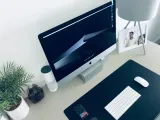When you work alone, every click matters.
You start to notice how tiny bits of friction — waiting for a build, syncing files, chasing notifications — stack up until the day feels heavy.
Over time, I’ve tried to build a setup that feels the opposite of that.
A workflow that’s fast, calm, and intentional.
These aren’t “productivity hacks.”
They’re small tools that quietly make my workday easier, and they all share one trait: they get out of the way.
The Tools I Keep Coming Back To
Most people collect tools like trophies. I do the opposite.
If something isn’t earning its keep, I remove it.
My current stack is small on purpose:
- One tool for writing.
- One for publishing.
- One for tracking small ideas before they vanish.
- And a few helpers that make the in-between moments smoother.
That’s it.
✍️ Writing Without Distractions
I used to think I needed a dozen writing apps.
Then I realized what I really needed was space — and a cursor that didn’t lag.
For me, writing well isn’t about word count. It’s about focus. The tool that helped me find that rhythm is what I now use to publish every post on this site.
Build your own space on the web. Publish fast, stay independent, and keep full control of your content with Ghost.
🛠️ For Building and Debugging
I write code the same way I write posts: in bursts of clarity. Most of my work happens in short sprints — a few focused hours, then a pause. That means I rely on tools that start quickly and don’t slow me down.
A lightweight editor like VS Code with just the essentials.
A terminal window that remembers my most-used scripts.
A couple of shell aliases to handle repetitive tasks.
🌱 For Thinking and Remembering
I use Notion for projects that need structure, but most of my ideas start in plain text. Markdown files in a synced folder. No folders-within-folders, no custom templates. Just words.
# Idea: small things that make big difference
- Problem: friction in dev workflow
- Solution: build a cleaner, fewer-click pipeline
- Notes: mention clarity > complexityHalf of these ideas never turn into projects. That’s fine, ideas are like compost. They feed the next thing.
☕ For Focus and Flow
I time my work using the simplest method I know: a playlist and a cup of coffee.
When the playlist ends, I stop coding.
I don’t use pomodoro timers or analytics dashboards.
I’d rather listen to my own energy levels than a graph.
Some days I can write for hours. Other days, it’s twenty good minutes.
That’s enough. The goal is to finish the day lighter than you started it.
🧭 The Principle Behind It All
Every tool I keep must do one of three things:
- Help me think more clearly.
- Help me create faster.
- Help me share without friction.
If it doesn’t fit any of those, it’s gone.
I’ve learned that simplifying your tools isn’t about minimalism for its own sake.
It’s about protecting your attention — the most limited resource we have.
Final Thoughts
Your workflow should make you feel in control — not constantly behind.
The tools you use should fade into the background so your ideas can take the front seat.
Ghost, markdown, and a few small utilities help me get there.
They remind me that clarity scales better than complexity.
If you’re looking for a place to publish that feels calm, modern, and yours — you might like the same setup.



